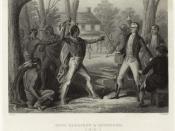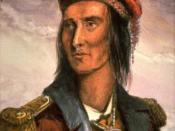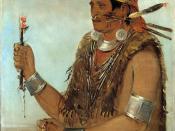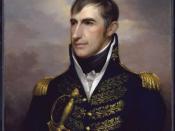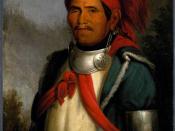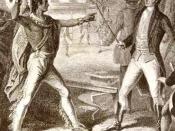The mixing of the Indian and European lifestyles influenced everyone's lives. Throughout time one could see the two sides unit together as one and one could also see them collide with disastrous ends. The Indians and the white men would unit to make peaceful treaties. Then the treaty would get broken and the two groups would collide in battle. Even when the Europeans and the Indians finally agreed on a way they both could farm and hunt, it eventually turned out hurt the Indian's way of life. The Europeans also affected the Indian's culture in both positive and negative ways. David Edmunds explains and shows examples of how the two groups mixed in his book, Tecumseh and the Quest for Indian Leadership.
Europeans settled in North America, claiming land that was never theirs to claim. The British initially made a deal to protect the Indians, but dishonored the deal when a battle broke.
During this battle, many Shawnee fled the battlegrounds to a British Fort where they were not allowed. They were hoping that the fort would give them protection. The trespassing Indians were taken as prisoners. On August 3rd, the Indians signed a treaty calling for them to remain at peace, relinquish all the prisoners, and give up the land in the southern, eastern, and central Ohio. In return the white men gave the Indians goods, valued from $5,000 to $10,000.
The Shawnees' lives were simple and they were spiritual people. The role for of men and women were also very simple. The men were the hunters and warriors. While the women were used as the housekeepers, clothe makers, and kept the families close. In the spring and summer months the two main projects were to farm and to re-build the villages. During the fall and winter months the Shawnee hunted, which allowed them to feed their families. By the early 1800's the Indian life became much more difficult. The white hunters wiped out most of the wildlife, forcing the Indians to start using more modern, "white man", ways of hunting. An agreement was made that would set up farming for both the Indians and the British. In 1807 the British sent William Kirk on a mission to Wapakoneta to finalize the plans with the Indians. The mission was a success, but in the long run hurt the Shawnees' ways of life.
The "white men" did not only change the way the Shawnee hunted and harvested for food, but they were also rapidly taking place in the Shawnee culture. Not all of the lifestyle changes had negative effects upon the Indians, but things such as European diseases did. White men carried diseases that the tribal medicine leaders were unable to cure and therefore, killed many Indians. Materialism was another problem the Indians, whom in the past were communal people, had to face. The white men were greedy and out for themselves, something the always-sharing Indians were not use to. The frontiersmen also introduced the Indians to whiskey, which paved the way for alcoholism amongst the tribes' people. The European lifestyle brought by the white settlers was infringing upon the Indians.
All that was happening was influencing Tecumseh, a Shawnee Indian. Born in 1768 in Ohio, Tecumseh was well liked by his peers, even as a child. When his father was killed in battle with white men, his brother Chiksika took Tecumseh under his wing and taught him the ways of the Shawnee warriors. The two remained close until Chiksika's death, also in battle with white men. On the other hand, Tecumseh's younger brother, Lalawethika, wasn't well liked. He never developed the skills of a warrior that Tecumseh possessed, and was a poor provider for his family. He was an alcoholic by his mid-twenties. After a failed attempt at being a shaman, Lalawethika went into a deep trance one night. It was so deep that his wife and neighbors thought he was dead. When he awoke he claimed that the Master of Life had chosen him to return and lead the Indians to salvation through his new religion. Lalawethika now become known as Tenskwatwa, or more commonly in the book as the Prophet. He began to spread his new religion. The religion spread quickly and soon had many followers. The Prophet was now a prominent figure of the Shawnee life.
In 1809 tribes in the Indiana Territory surrendered much of their land to the United States, due to the Treaty of Fort Wayne. Tecumseh protested to Governor William Henry Harrison but was unsuccessful. With this tremendous effort Tecumseh stepped from the shadow as the Prophet's brother and became the main leader of the Indian movement. Being a war chief, Tecumseh believed that "only assertive political and military leadership could protect the Indian land base." He decided to carry his message to the southern tribes. Overall, he had little success in his talks with the southern tribes.
During Tecumseh's travels to the south, Harrison took advantage of his absence and decided to attack Prophet's Town, the town where most of Tecumseh's followers lived. This attack's end result was The Battle of Tippecanoe. The Prophet, whom in Tecumseh's absence was left in charge, led the Indians in a major defeat. This was a major blow to the Indian movement and many of the followers blamed the Prophet. With this defeat in their minds many of them returned to their homes.
After Tecumseh's return, he joined the British against the Americans in the War of 1812. As a general, Tecumseh led 2,000 warriors into battle. He fought at Frenchtown, Raisin River, Fort Meigs, and Fort Stephenson. His last battle was the Battle of the Thames where he was killed leading his warriors. Like his father and brother before him, Tecumseh died fighting the white men. Consequently, the Indian movement died with Tecumseh.
Edmunds' shows that Tecumseh, a Shawnee warrior chief, whom with his brother, the Shawnee Prophet, attempted to stop the advance of white race. Tecumseh believed that all of the Indian tribes should work together and should not sell any of their land to the white men. He wanted the Indian's way of life to be how it once use to be, pure and simple. The Indians fought many battles, stood up for what they believed in, and demanded that they received the goods promised to them. These examples show that the Native American's were not a race that could easily be taken over. The events that took place throughout the time of Tecumseh and the Quest for Indian Leadership are events that have forever changed the history of the United States of America.
